Xuhui Liu
Surf3R: Rapid Surface Reconstruction from Sparse RGB Views in Seconds
Aug 06, 2025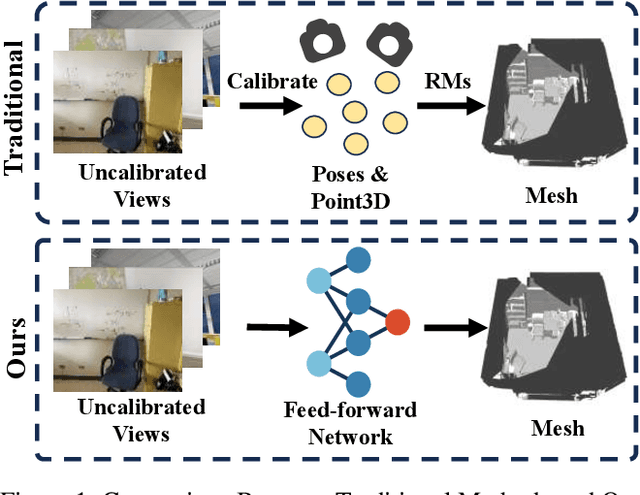

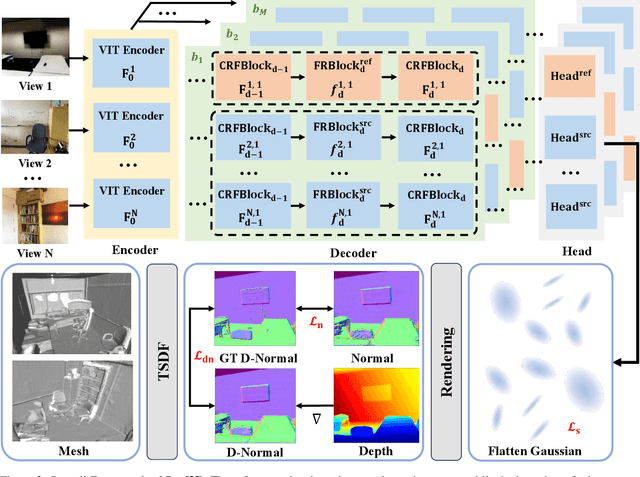

Abstract:Current multi-view 3D reconstruction methods rely on accurate camera calibration and pose estimation, requiring complex and time-intensive pre-processing that hinders their practical deployment. To address this challenge, we introduce Surf3R, an end-to-end feedforward approach that reconstructs 3D surfaces from sparse views without estimating camera poses and completes an entire scene in under 10 seconds. Our method employs a multi-branch and multi-view decoding architecture in which multiple reference views jointly guide the reconstruction process. Through the proposed branch-wise processing, cross-view attention, and inter-branch fusion, the model effectively captures complementary geometric cues without requiring camera calibration. Moreover, we introduce a D-Normal regularizer based on an explicit 3D Gaussian representation for surface reconstruction. It couples surface normals with other geometric parameters to jointly optimize the 3D geometry, significantly improving 3D consistency and surface detail accuracy. Experimental results demonstrate that Surf3R achieves state-of-the-art performance on multiple surface reconstruction metrics on ScanNet++ and Replica datasets, exhibiting excellent generalization and efficiency.
Light of Normals: Unified Feature Representation for Universal Photometric Stereo
Jun 24, 2025Abstract:Universal photometric stereo (PS) aims to recover high-quality surface normals from objects under arbitrary lighting conditions without relying on specific illumination models. Despite recent advances such as SDM-UniPS and Uni MS-PS, two fundamental challenges persist: 1) the deep coupling between varying illumination and surface normal features, where ambiguity in observed intensity makes it difficult to determine whether brightness variations stem from lighting changes or surface orientation; and 2) the preservation of high-frequency geometric details in complex surfaces, where intricate geometries create self-shadowing, inter-reflections, and subtle normal variations that conventional feature processing operations struggle to capture accurately.
MASS: Multi-Agent Simulation Scaling for Portfolio Construction
May 15, 2025Abstract:LLM-based multi-agent has gained significant attention for their potential in simulation and enhancing performance. However, existing works are limited to pure simulations or are constrained by predefined workflows, restricting their applicability and effectiveness. In this paper, we introduce the Multi-Agent Scaling Simulation (MASS) for portfolio construction. MASS achieves stable and continuous excess returns by progressively increasing the number of agents for large-scale simulations to gain a superior understanding of the market and optimizing agent distribution end-to-end through a reverse optimization process, rather than relying on a fixed workflow. We demonstrate its superiority through performance experiments, ablation studies, backtesting experiments, experiments on updated data and stock pools, scaling experiments, parameter sensitivity experiments, and visualization experiments, conducted in comparison with 6 state-of-the-art baselines on 3 challenging A-share stock pools. We expect the paradigm established by MASS to expand to other tasks with similar characteristics. The implementation of MASS has been open-sourced at https://github.com/gta0804/MASS.
Reconstruct Spine CT from Biplanar X-Rays via Diffusion Learning
Aug 21, 2024

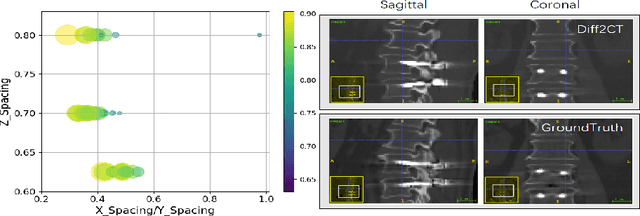
Abstract:Intraoperative CT imaging serves as a crucial resource for surgical guidance; however, it may not always be readily accessible or practical to implement. In scenarios where CT imaging is not an option, reconstructing CT scans from X-rays can offer a viable alternative. In this paper, we introduce an innovative method for 3D CT reconstruction utilizing biplanar X-rays. Distinct from previous research that relies on conventional image generation techniques, our approach leverages a conditional diffusion process to tackle the task of reconstruction. More precisely, we employ a diffusion-based probabilistic model trained to produce 3D CT images based on orthogonal biplanar X-rays. To improve the structural integrity of the reconstructed images, we incorporate a novel projection loss function. Experimental results validate that our proposed method surpasses existing state-of-the-art benchmarks in both visual image quality and multiple evaluative metrics. Specifically, our technique achieves a higher Structural Similarity Index (SSIM) of 0.83, a relative increase of 10\%, and a lower Fr\'echet Inception Distance (FID) of 83.43, which represents a relative decrease of 25\%.
DiffuX2CT: Diffusion Learning to Reconstruct CT Images from Biplanar X-Rays
Jul 18, 2024

Abstract:Computed tomography (CT) is widely utilized in clinical settings because it delivers detailed 3D images of the human body. However, performing CT scans is not always feasible due to radiation exposure and limitations in certain surgical environments. As an alternative, reconstructing CT images from ultra-sparse X-rays offers a valuable solution and has gained significant interest in scientific research and medical applications. However, it presents great challenges as it is inherently an ill-posed problem, often compromised by artifacts resulting from overlapping structures in X-ray images. In this paper, we propose DiffuX2CT, which models CT reconstruction from orthogonal biplanar X-rays as a conditional diffusion process. DiffuX2CT is established with a 3D global coherence denoising model with a new, implicit conditioning mechanism. We realize the conditioning mechanism by a newly designed tri-plane decoupling generator and an implicit neural decoder. By doing so, DiffuX2CT achieves structure-controllable reconstruction, which enables 3D structural information to be recovered from 2D X-rays, therefore producing faithful textures in CT images. As an extra contribution, we collect a real-world lumbar CT dataset, called LumbarV, as a new benchmark to verify the clinical significance and performance of CT reconstruction from X-rays. Extensive experiments on this dataset and three more publicly available datasets demonstrate the effectiveness of our proposal.
Fusion-Mamba for Cross-modality Object Detection
Apr 14, 2024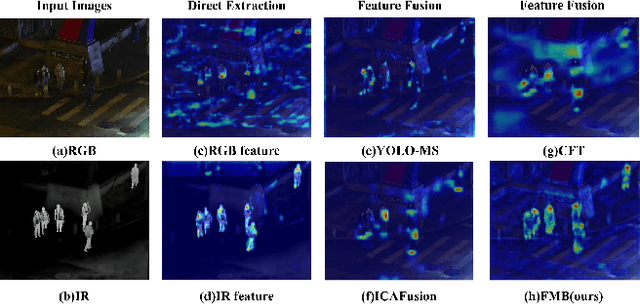
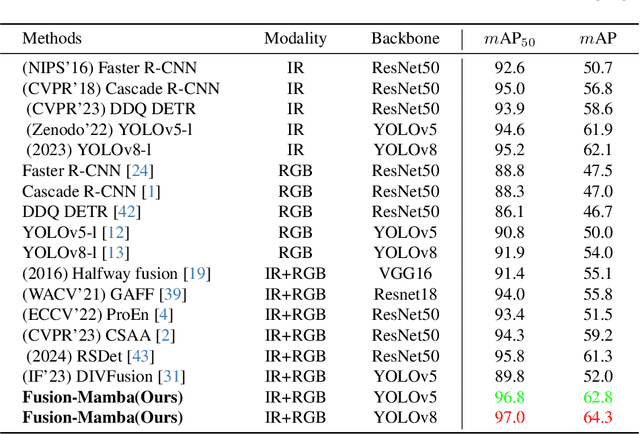
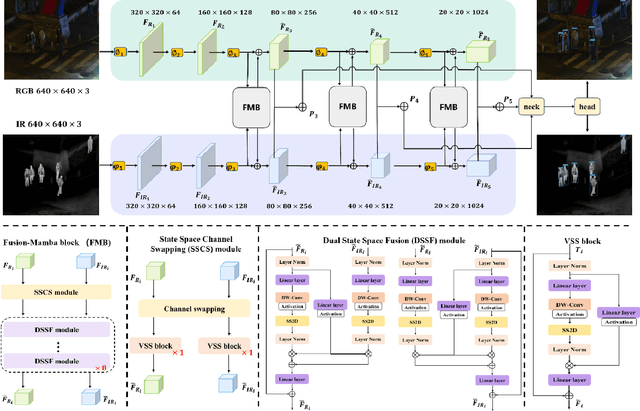
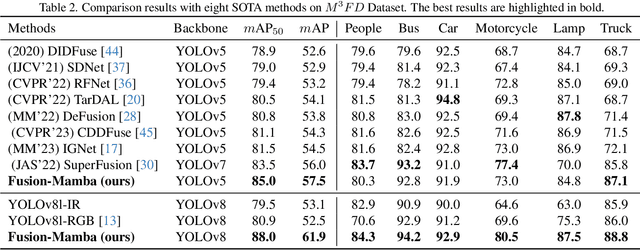
Abstract:Cross-modality fusing complementary information from different modalities effectively improves object detection performance, making it more useful and robust for a wider range of applications. Existing fusion strategies combine different types of images or merge different backbone features through elaborated neural network modules. However, these methods neglect that modality disparities affect cross-modality fusion performance, as different modalities with different camera focal lengths, placements, and angles are hardly fused. In this paper, we investigate cross-modality fusion by associating cross-modal features in a hidden state space based on an improved Mamba with a gating mechanism. We design a Fusion-Mamba block (FMB) to map cross-modal features into a hidden state space for interaction, thereby reducing disparities between cross-modal features and enhancing the representation consistency of fused features. FMB contains two modules: the State Space Channel Swapping (SSCS) module facilitates shallow feature fusion, and the Dual State Space Fusion (DSSF) enables deep fusion in a hidden state space. Through extensive experiments on public datasets, our proposed approach outperforms the state-of-the-art methods on $m$AP with 5.9% on $M^3FD$ and 4.9% on FLIR-Aligned datasets, demonstrating superior object detection performance. To the best of our knowledge, this is the first work to explore the potential of Mamba for cross-modal fusion and establish a new baseline for cross-modality object detection.
ZONE: Zero-Shot Instruction-Guided Local Editing
Dec 28, 2023
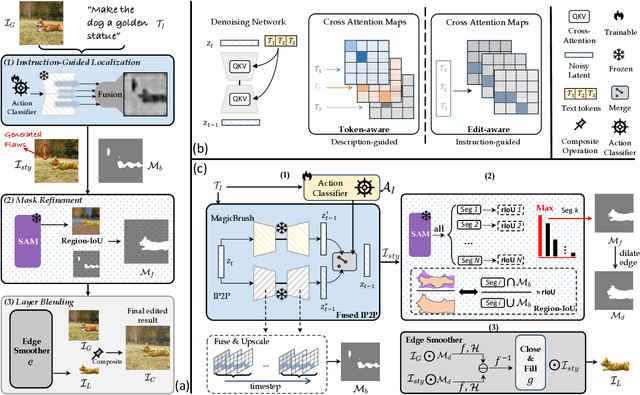
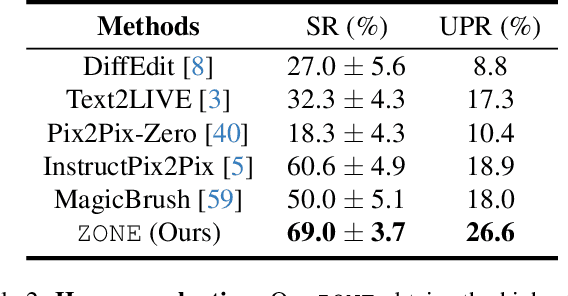
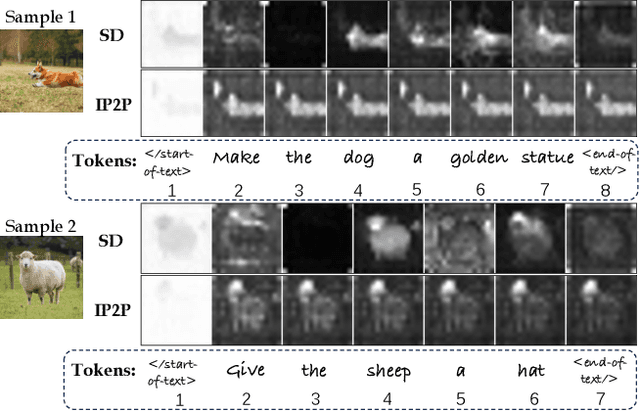
Abstract:Recent advances in vision-language models like Stable Diffusion have shown remarkable power in creative image synthesis and editing.However, most existing text-to-image editing methods encounter two obstacles: First, the text prompt needs to be carefully crafted to achieve good results, which is not intuitive or user-friendly. Second, they are insensitive to local edits and can irreversibly affect non-edited regions, leaving obvious editing traces. To tackle these problems, we propose a Zero-shot instructiON-guided local image Editing approach, termed ZONE. We first convert the editing intent from the user-provided instruction (e.g., ``make his tie blue") into specific image editing regions through InstructPix2Pix. We then propose a Region-IoU scheme for precise image layer extraction from an off-the-shelf segment model. We further develop an edge smoother based on FFT for seamless blending between the layer and the image.Our method allows for arbitrary manipulation of a specific region with a single instruction while preserving the rest. Extensive experiments demonstrate that our ZONE achieves remarkable local editing results and user-friendliness, outperforming state-of-the-art methods.
Q-YOLO: Efficient Inference for Real-time Object Detection
Jul 01, 2023Abstract:Real-time object detection plays a vital role in various computer vision applications. However, deploying real-time object detectors on resource-constrained platforms poses challenges due to high computational and memory requirements. This paper describes a low-bit quantization method to build a highly efficient one-stage detector, dubbed as Q-YOLO, which can effectively address the performance degradation problem caused by activation distribution imbalance in traditional quantized YOLO models. Q-YOLO introduces a fully end-to-end Post-Training Quantization (PTQ) pipeline with a well-designed Unilateral Histogram-based (UH) activation quantization scheme, which determines the maximum truncation values through histogram analysis by minimizing the Mean Squared Error (MSE) quantization errors. Extensive experiments on the COCO dataset demonstrate the effectiveness of Q-YOLO, outperforming other PTQ methods while achieving a more favorable balance between accuracy and computational cost. This research contributes to advancing the efficient deployment of object detection models on resource-limited edge devices, enabling real-time detection with reduced computational and memory overhead.
Controllable Mind Visual Diffusion Model
May 18, 2023Abstract:Brain signal visualization has emerged as an active research area, serving as a critical interface between the human visual system and computer vision models. Although diffusion models have shown promise in analyzing functional magnetic resonance imaging (fMRI) data, including reconstructing high-quality images consistent with original visual stimuli, their accuracy in extracting semantic and silhouette information from brain signals remains limited. In this regard, we propose a novel approach, referred to as Controllable Mind Visual Diffusion Model (CMVDM). CMVDM extracts semantic and silhouette information from fMRI data using attribute alignment and assistant networks. Additionally, a residual block is incorporated to capture information beyond semantic and silhouette features. We then leverage a control model to fully exploit the extracted information for image synthesis, resulting in generated images that closely resemble the visual stimuli in terms of semantics and silhouette. Through extensive experimentation, we demonstrate that CMVDM outperforms existing state-of-the-art methods both qualitatively and quantitatively.
Face Animation with an Attribute-Guided Diffusion Model
Apr 06, 2023
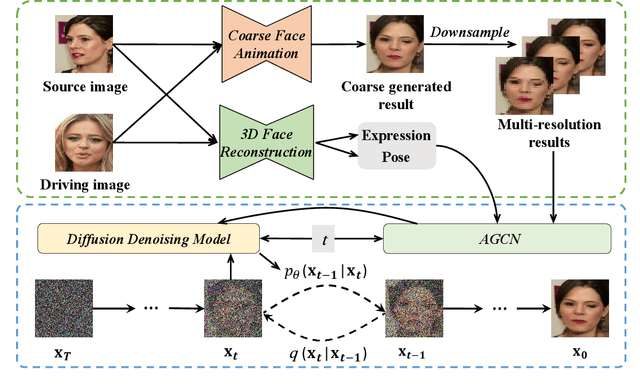

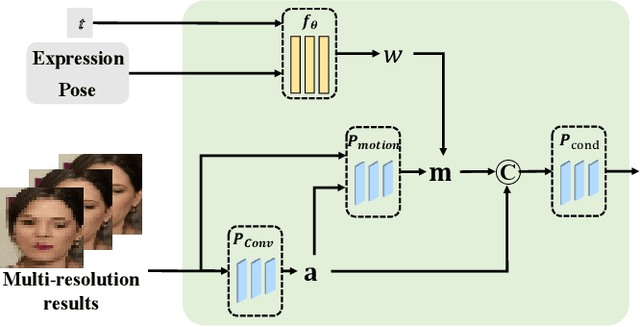
Abstract:Face animation has achieved much progress in computer vision. However, prevailing GAN-based methods suffer from unnatural distortions and artifacts due to sophisticated motion deformation. In this paper, we propose a Face Animation framework with an attribute-guided Diffusion Model (FADM), which is the first work to exploit the superior modeling capacity of diffusion models for photo-realistic talking-head generation. To mitigate the uncontrollable synthesis effect of the diffusion model, we design an Attribute-Guided Conditioning Network (AGCN) to adaptively combine the coarse animation features and 3D face reconstruction results, which can incorporate appearance and motion conditions into the diffusion process. These specific designs help FADM rectify unnatural artifacts and distortions, and also enrich high-fidelity facial details through iterative diffusion refinements with accurate animation attributes. FADM can flexibly and effectively improve existing animation videos. Extensive experiments on widely used talking-head benchmarks validate the effectiveness of FADM over prior arts.
 Add to Chrome
Add to Chrome Add to Firefox
Add to Firefox Add to Edge
Add to Edge